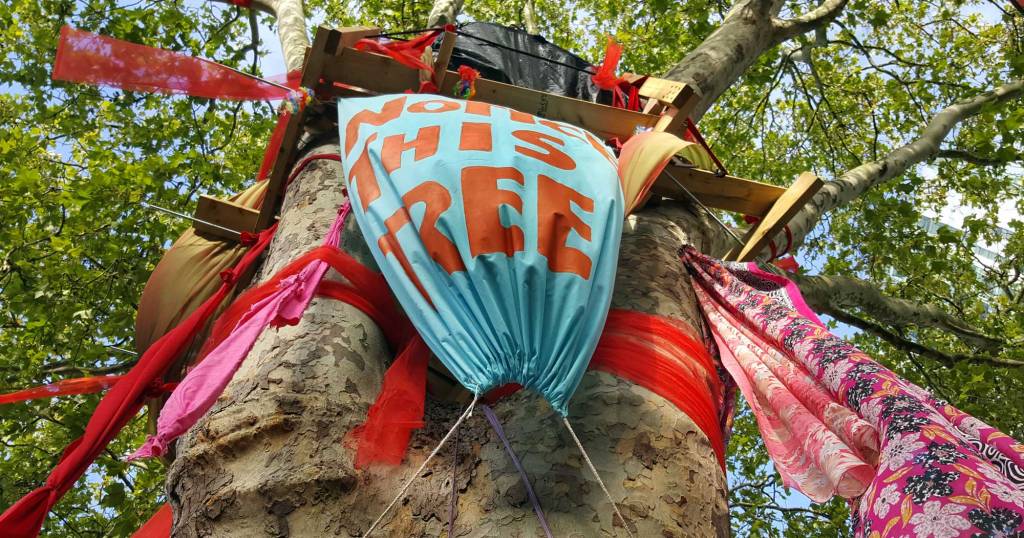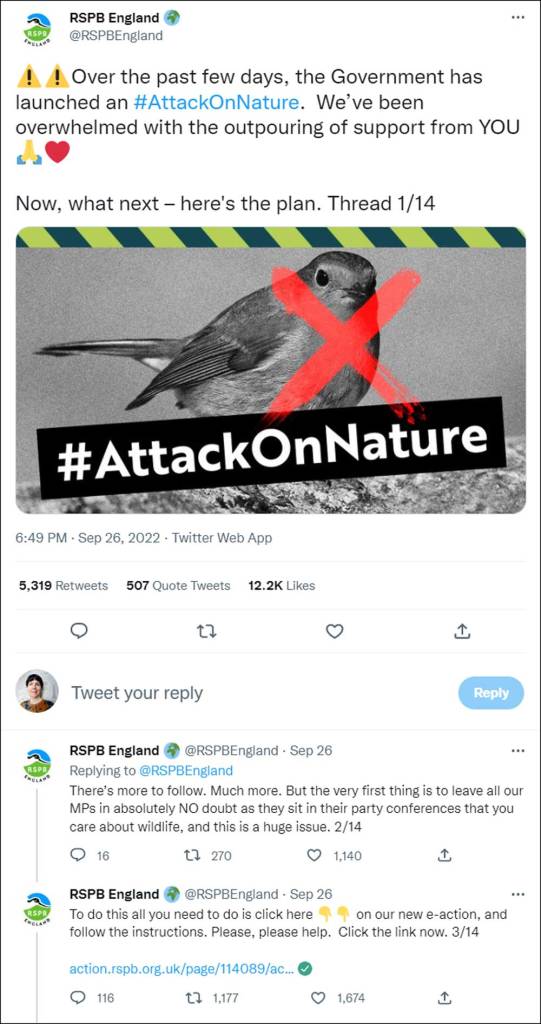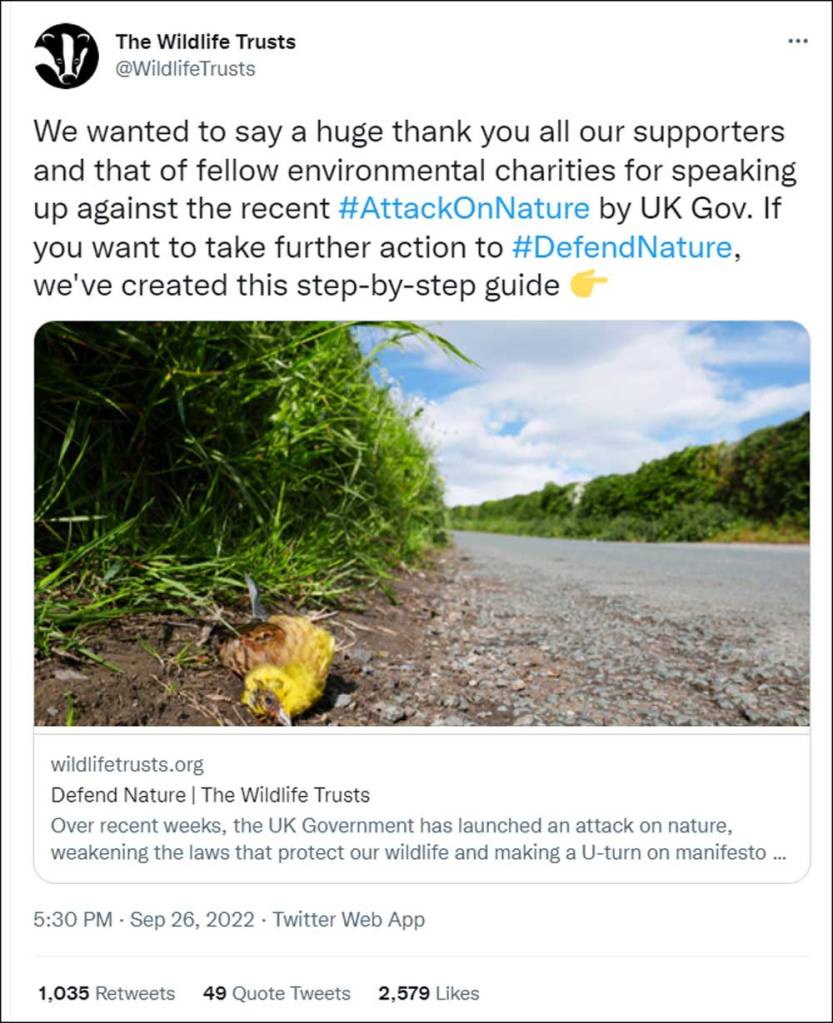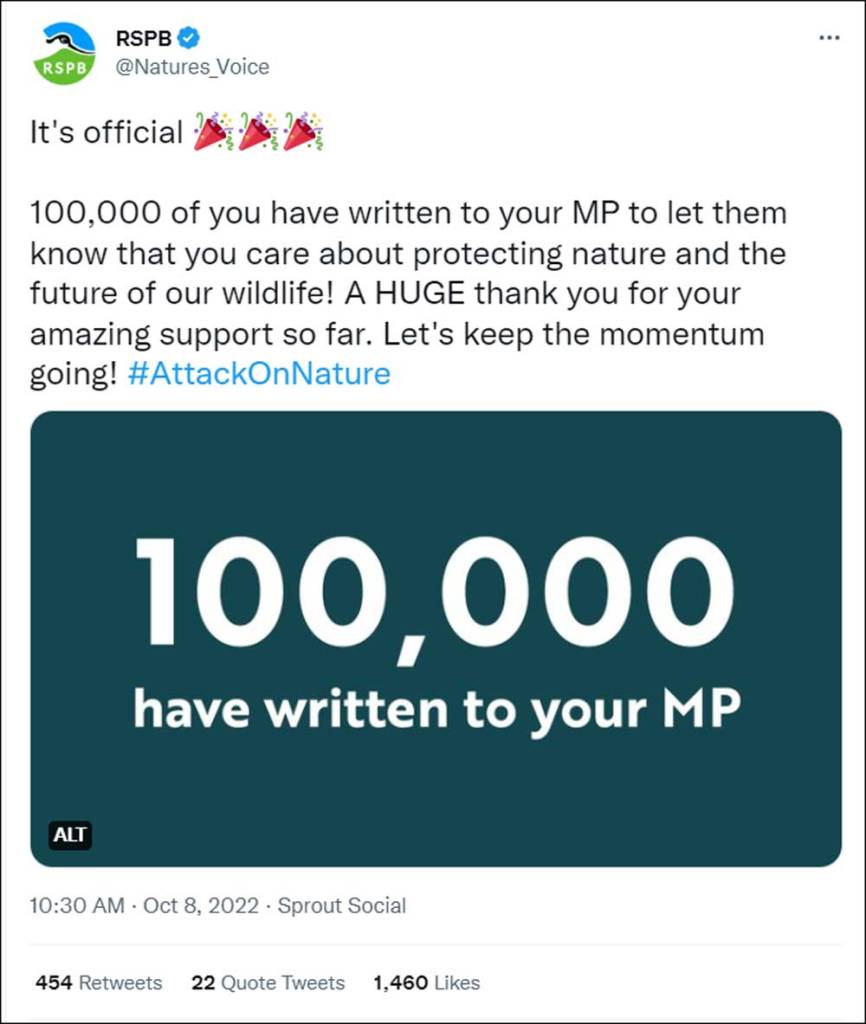
When the major conservation charities show their anger and mobilise their memberships of millions, there’s something big to fight. In the week of the mini budget, it was announced that laws protecting wildlife and green places would be amended or scrapped and planning regulations would be eased in investment zones to accelerate growth. At a time when nature is under threat and the climate is on a knife-edge, these decisions were seen as an attack on nature by conservation groups and they swung into action as never before.
The challenge was to mobilise the usually small-c conservative memberships, to explain the complexities of what was being proposed, to fight for change. Could they speak with one voice? Could they get the Government to hear the anger and consider a rethink? Would it unite or alienate the charity’s memberships?
In the three weeks since this started, Twitter has been the focus of messaging and campaigning. Here are some examples of how different organisations responded, the comms and calls to action they shared, and what the impact has been so far.
RSPB
On Thursday 22 September, RSPB tweeted to say that they were “deeply concerned that the Government is about to start a full-on attack on the laws that protect nature”. Strong words from a usually friendly account. By the next day, following the mini budget, things had escalated.
“Make no mistake, we are angry.” These stark words following the mini budget, sent at 6.40pm on Friday 23rd set the tone for the campaign. This 13-tweet thread explained the situation and its urgency (“If ever nature has needed you, it’s now.”). It has been liked 70k+ times and shared 40k+ times. People and other organisations replied to the thread in support. I saw people saying that they had joined or renewed their membership. The emoji, strong words and black and white image with the quote made people notice this tweet. It became the poster tweet for the campaign. (Note that the same content shared on Facebook on the Monday got much less engagement.)

Some of the other big conservation charities also tweeted concern. Here’s a thread of those initial responses from Woodland Trust, The Wildlife Trusts and the National Trust.
Over the weekend, RSPB responded to the outcry and shared a watch this space thread on Sunday and used the #AttackOnNature hashtag for the first time.
On Monday, the action started. A 14-tweet thread with a black and white image of a robin with a red X across it, described ‘the plan’. It included an e-action, a specially worded email to send to MPs in England.

The Guardian observed the activity and reported on the story – ‘We are angry’: green groups condemn Truss plans to scrap regulations and Green charities urge millions of members to oppose Tories’ ‘attack on nature’. They also reported on the backlash – Tory MPs dismiss critical RSPB campaign as ‘marketing strategy.
RSPB maintained high activity to keep up the momentum. They changed their homepage from an autumn story about migrating birds, to the campaign. On Twitter and their other channels, they shared updates and explained the detail of the proposals all with an approachable tone of voice (“thanks for sticking with us“). This 18-tweet thread contains just text. A thread from their Conservation Science team added more technical detail. Information was shared about meetings with ministers. And a more detailed explainer about investment zones was shared. They appear to have stopped all other messaging except for the campaign. There are no nice bird pictures to distract from the job in hand. They’ve been adding information, answering questions, sharing updates, keeping people involved. Understandably engagement has dropped from that initial huge spike for the mega tweet but threads are still getting thousands of likes.
To date, over 109,000 people have used the e-action site. In the past three days 10k people have used it. They are likely to be a mix of members and non-members so presumably there is still huge scope for this to have more impact. RSPB’s membership is 1.2 million people.
A quick look around individual RSPB accounts from specific reserves and areas found RTs of the corporate messages but otherwise business as usual with opening times and sightings. A missed opportunity to regionalise support?
RSPB have helpfully shared a timeline of the campaign to date (Attack on Nature – the story so far) and say that there is more to come. The RSPB are ‘not ruling out’ direct action to defend nature from government policy and they have talked about the rage of Middle England.
While RSPB seemed to lead the response, other big organisations quickly followed.
The Wildlife Trusts
The Wildlife Trusts have driven a similar campaign of action and information. They used the #AttackOnNature hashtag and added #DefendNature. Their 5-step action was to tweet and email your MP and local councillor (“This impacts where you live and they need to speak up too”). 1400+ people have pledged to do these actions.

The Wildlife Trusts have been sharing campaign messages alongside their usual positive comms. They wrote a comprehensive blog post (Defra fails to assuage fears over deregulation and farming reforms) and shared direct to camera pieces from well-known conservation experts.
Some local Wildlife Trusts have been mobilising their supporters. There have been meetings like this one in Hampshire attended by Chris Packham and members of other local groups. Surrey Wildlife Trust shared their own calls to action. Sussex Wildlife Trust shared a video from their reserve. One of Essex Wildlife Trusts’ ecologists spoke on a video. The CEO of Herefordshire Wildlife Trust spoke to the BBC. Yorkshire Wildlife Trust’s CEO spoke to the Yorkshire Post (Government must rethink dangerous environmental plans). Kent Wildlife Trust shared a video saying “Please be angry”.
In week three, The Wildlife Trusts, added postcards to send to MPs.
United we stand
Many environment and conservation charities took to Twitter to add their voices.
Campaign letters:
- Woodland Trust called for a cast iron commitment from the government that it wouldn’t turn its back on woods, trees and wildlife. 330+ people have emailed their MP via the campaign.
- WWF said no more broken promises and launched their own MP letter. They also said that more than a million people saw their thread about farming.
- Ramblers GB launched their own MP letter, saying ‘protecting nature and people’s access to it is vital’.
- “We will need your help to stop this environmental vandalism,” asked the Bat Conservation Trust who shared their own letter.
- BugLife encouraged their members to write to their MPs via the RSPB. As did Rewilding Britain.
Statements:
- National Trust’s Director General made a statement. And later issued a press release – Green not grey growth and a blog post – Campaigning for beauty, nature and heritage. Her threat of mobilisation of 5.7million members was reported in The Times.
- The Community Planning Alliance wrote to the Secretary of State, Simon Clarke MP. They represent 613 grassroots groups campaigning against local developments threatening green spaces. They stood in solidarity with the sector.
- The Botanical Society of Britain and Ireland wrote to the Secretary of State, Ranil Jayawardena MP.
- CPRE made a statement. ‘Deregulation on steroids’ – our response to planned investment zones.
- Bumblebee Conservation Trust issued a statement in a 6-tweet thread (their most liked ever) and Facebook post.
Other actions:
- 37k people have signed Friends of the Earth’s petition.
- CPRE shared a cartoon illustrating Liz Truss’s conference speech.
Coalitions of support:
- An open letter was sent to Liz Truss from 79 charity CEOs under the umbrella of the Wildlife and Countryside Link (WCL). It was reported in the Daily Express.
- 12 organisations signed an open letter published in The Telegraph – No-one can afford for nature to be under attack.
- A joint blog from the CEOs of Campaign for National Parks and National Association of AONBs argued for “Not blind opposition to progress. But opposition to blind progress.”
In this spirit of joined-up activity, where are the voices of the ethnic groups, the disability forums, the travelling communities? I’ve seen tweets where people are saying this is their fight too but they don’t feel included. Action may look different for them from the lobbying and letters in newspapers. They may be taking action in their own way which we can’t see. Or they may not see themselves as campaigning organisations or only campaign on their specific area or don’t use Twitter or digital comms for campaigning. This campaign is happening in the open so being part of it means speaking out.
The People’s Plan for Nature
Once a supporter has sent an email to their MP and councillor, what do they do next? People feel angry and powerless. How can that be harnessed and turned into action and a collective voice? WWF, National Trust and RSPB have come together to drive action through the People’s Plan for Nature. It’s unclear whether this was planned anyway or was pulled together as a result of the #AttackOnNature.
The call to action is: Join the UK’s biggest conversation about the future of nature and make your voice heard. It asks three questions with a deadline of 30 October.

National Trust shared this video promoting the campaign.
See also: #LettersToTomorrow, a climate change project. This message from Aneeshwar says everything.
Thoughts and questions
This is a campaign like no other we have seen from the conservation / environment sector. The response by so many organisations has been quick and strong. The sense of urgency is shared and from the outside there seems to be solidarity and collective action.
The proposals from the Government have provoked reaction from people and organisations not used to challenging things on this scale. The cost of living crisis, war in Ukraine, death of the Queen and countless other stresses mean that we are all operating in an intense time. Protections, standards and legislation are no longer set in stone. Charities are increasingly having to develop campaigning skills to fight for what they think is right without straying into party politics (and therefore keeping on the right side of the Charity Commission).
That this campaign is being done on such a large scale is both impressive and necessary against such harsh proposals. Will we see more of this type of collective action in other areas too?
The #AttackOnNature campaign is not owned by any one charity. Yet the messaging is pretty consistent and the actions are too. Where will this go next? What might have more impact than emails, media coverage and social media activity, which are the standard tools for charities like these?
Substantial retreats in Government policy, especially during at times of multiple crisis, means achieving cut-through for any campaign is going to be tough. How will charities deal with campaign fatigue over the medium to long-term?
Social media, primarily Twitter has been where this campaign has been visible so far. But with such headwinds, are the charities doing enough to reach the considerable number of members who are not on social media or email?
Digital comms learnings
The impact of the initial response from RSPB was so significant because they showed anger. This was a shift from their usual tone of voice so it made people take notice that something big was happening. They made their position clear within the first six words of their tweet. Tone of voice matters.
This was a useful lesson in crisis comms / campaigning. Many organisations responded quickly. Some worked over the weekend so that the action was ready to go on the Monday. Anger and action are time specific, they don’t wait. Supporters need to see that you care as much as they do. They want something to do. This campaigning used a digital comms, responsive approach.
Much of the sector came together through this. This was collective, joined-up campaigning on one issue. As we have seen above, high profile organisations quickly stated their public support for each other and endorsed a shared message adding their own expertise and comms with their members. Historically joined-up campaigning has been rare as they protect their memberships and fundaising, so this felt like a significant moment. There were however noteable gaps with some large organisations and many small ones still not doing or saying anything publicly. At what cost?
Keeping up the pressure and momentum of a campaign is hard. Having new things to say – new asks, updates about progress, explainers, guest voices of supporters, small actions – helps. It all has to be purposeful. A consistent tone of voice, use of hashtag and imagery is important too so people can spot updates. Sharing milestones is important too (like this tweet from RSPB on reaching the massive milestone of 100k letters). And saying thank you.

** Update: learnings from #AttackOnNature campaign
I wrote a summary of the panel discussion at the Charity Comms Digital Conference which I hosted featuring RSPB, Bumblebee Conservation Trust and the Community Planning Alliance. **
Your views
What do you think? Have you noticed other responses to this campaign? Have you seen anything on this scale before? Do you work in a conservation charity and have a different view? I’d love to hear from you.
We’ll be discussing this issue in a panel discussion on the first day of the Charity Comms Digital conference in November. Please join us.
Updates
Direct action
Direct action not ruled out by conservation groups over environment policies – BBC report (12 October) on the CEOs of RSPB, Wildlife Trusts and National Trust coming together with their combined membership of 8 million. “We choose our battles very carefully – and we don’t do it very often.” RSPB tweeted that they are still considering their next moves.
Do marches work – listen to this programme on Radio 4. New policing powers also mean that marches and protests are under scrutinity as never before. Can the leaders be more creative? Maybe take inspiration from #TheQueue and make a protective wall around nature? Something like the The Baltic Way. People could do it in their own communities rather than having to travel. They could join forces by holding hands, making a wall round their local green space or nature reserve. Charities with their own nature reserves could host too.
Local action
Other reads
- Inferno of environmental regulations – Rosie Pearson on LinkedIn
- Truss Government’s ‘attack on nature’ – Natalie Bennett, Green Party
- Nature calls: new think tank klaxon – comms 101 – Politico
- Working together for a diverse nature sector – Wildlife and Countryside Link (WCL)